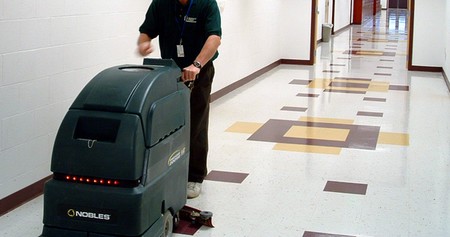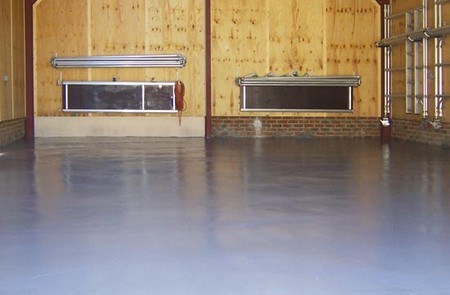Concrete flooring is practical and efficient in many applications: garage floors, basement floors, and porches. But with use these floors acquire stains that need cleaning. Fortunately, good concrete needs little maintenance. Here’s how to clean a concrete floor and keep it clean.
Procedure:
BASIC MAINTENANCE
There are several types of concrete floors. Some are laid directly on the ground over a fill of cinders or gravel; others are laid over joists made of precast concrete; still others are solid slabs of reinforced concrete without joists. The first type of floor is used widely in homes with or without basements, and for garages.

Regular cleaning of concrete flooring with soap and warm water prevents dirt and grit from grinding into the finish and causing deterioration. Waxing with ordinary floor wax is also effective. You can clean colored concrete that has become extremely dirty by allowing liquid soap to stand overnight on the surface and by giving the floor a thorough washing job the next day.
If your concrete floor is equipped with a large floor drain or opens to the outside as a garage floor does, you can wash the floor using a sprayer attachment on a garden hose. Otherwise a string mop is the best scrubbing tool. There are a variety of effective cleaning agents for concrete floors from simple soaps and detergents to special concrete flooring cleaners available at building material retailers and janitorial supply outlets.
REMOVING STAINS
Stain removal is the principal cleaning task with concrete floors. Being a porous material, concrete absorbs stains, which you can either drive below the surface by solvents, or draw out of the concrete by absorbents. The absorbent “poultice” method, which we’ll discuss here, varies for different types of stain. Where strong chemicals are involved, you should wear gloves.
- To remove fresh oil and grease stains from concrete flooring, cover the stain with dry Portland cement or hydrated lime. Remove and replace this solution as it becomes soiled with the stain that is drawn out of the concrete.
- To remove old oil and grease stains on garage floors, cover the stain with an absorbent in powder form. Moisten with gasoline and lay a flap of canvas over it to retard evaporation. Replace the poultice as it becomes saturated with stain. For indoor floors, mix a strong solution of trisodium phosphate or washing soda, 2 pounds to 1 gallon of water. Scrub the stain repeatedly, then rinse thoroughly with clear water, then apply something like epoxy garage floor coating to keep it from staining again.
- To remove rust stains from concrete floors, dissolve 1 part sodium citrate in 6 parts water. Add 6 parts of commercial glycerin. Mix enough of this solution with powdered whiting or hydrated lime to form a thick paste. Spread a thick coat of this paste over the stain. As it dries, remoisten the paste with more solution. The stain should come out within a week of treatment.
- To remove copper and bronze stains from concrete floors, mix 1 part of sal ammoniac with 4 parts whiting or another absorbent. Moisten with ammonia and apply to the stain repeatedly. An alternative method is to dissolve sal ammoniac in ammonia and, using a brush, scrub the stain with this solution. Flush with water shortly after each application.
- To remove ink stains, cover the stain with cotton batting or thick flannel. If that doesn’t work, you can hire pressure washing experts like Coast Pro Wash.
- To remove soot stains, as from a furnace, mix Vi pound of trisodium phosphate (TSP) to one gallon of water. Apply to the stained parts of concrete and scrub with a stiff brush. Rinse thoroughly. This solution can harm woodwork, so you’ll need to protect any finished wood surfaces from it.
- To remove smoke and fire stains from concrete floors, first scrub the area with powdered pumice and water to remove surface dirt. Then dissolve 2 pounds of trisodium phosphate into 1 gallon of hot water. In an enameled pot or pottery dish mix 12 ounces of chloride of lime into a paste, and add it into the water slowly. Mix both solutions and paste in a pottery or stoneware vessel with enough water added to make 2 gallons. Stir well and, after covering the top of the vessel, let it stand until a clear liquid forms on top of the contents. Skim off the clear liquid, and saturate a flannel cloth folded to several thicknesses. Place the cloth over the stain and cover with a pane of glass to retard evaporation. Renew the cloth as necessary; several applications are required to remove the stain completely.
RESURFACING CONCRETE FLOORS
Resurfacing may be done in two ways: by replacing the existing topping if the original floor level must be preserved, or by laying new topping over the old.
- To replace the present topping, chip away at the old surface to a depth of at least 1 inch. Thoroughly clean the concrete thus exposed, scrubbing with a 10 percent muriatic acid solution or a strong washing solution. Saturate the surface with clean water and allow to stand overnight. Then prepare the topping and a thin grout. Sponge the excess water from the area to be resurfaced. Brush the grout over the prepared surface and place new concrete over it. Finish the surface and cure.
- To recover the old topping, prepare the surface as described above. Then mix the grout and concrete. Brushing on grout, place new concrete to at least a 2-inch thickness. It is desirable to reinforce it with light wire mesh. Finish and cure in the regular way.
